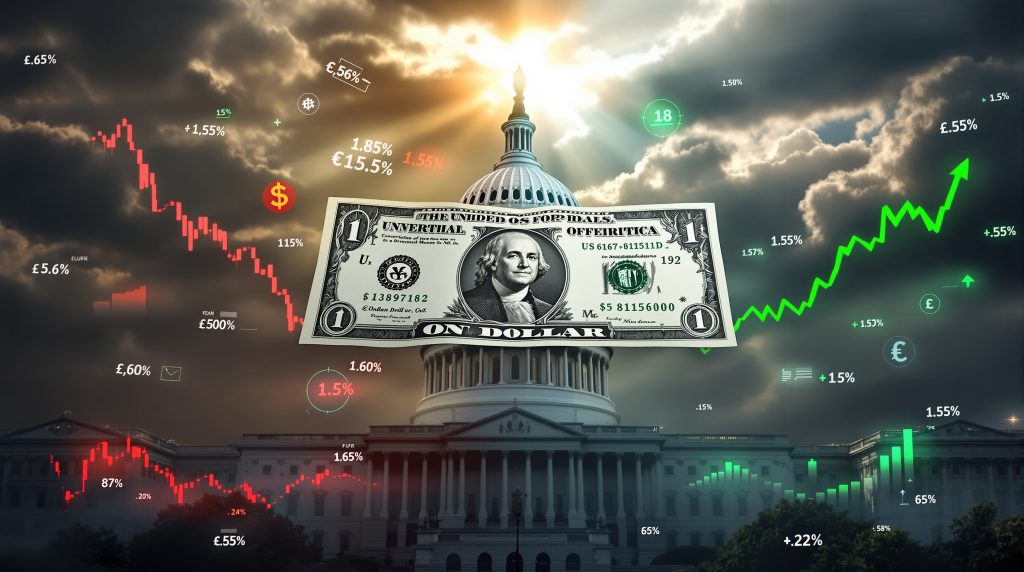What Happens to the US Dollar During a Government Shutdown?
A government shutdown in the United States thrusts the US dollar into a period of heightened uncertainty and volatility. As the primary global reserve currency, the dollar's movements during shutdowns are amplified by widespread investor attention. During a shutdown, the federal government suspends non-essential operations, major agencies slow or cease activity, and essential data releases are delayed. These disruptions cast doubt over fiscal governance and introduce uncertainty to global financial markets, directly affecting perceptions of the dollar.
Expert commentary highlights that this uncertainty often feeds into broader concerns about the structural integrity of US economy and debt. While the immediate cause of volatility may be the political impasse, underlying concerns—such as escalating debt levels—amplify the fragility of the dollar in the eyes of institutional investors and foreign governments.
Although the impact is often pronounced in the short term, the US dollar generally retains its value due to its status as the world's primary reserve currency and the lack of practical global alternatives.
How Do Financial Markets Typically React to Government Shutdowns?
Financial markets tend to view shutdowns as disruptive but temporary, resulting in reactions that are more muted than those from more significant economic shocks like recessions or major policy shifts.
Key recurring market phenomena during shutdowns include:
- Modest short-term declines in the dollar index at the beginning of shutdowns
- Increased volatility owing to uncertainty about the shutdown's duration
- Reduced trading volumes as investors adopt a cautious, wait-and-see approach
- Pricing adjustments in foreign exchange markets reflecting perceptions of economic risk
For instance, historical data shows that previous shutdowns resulted in limited depreciation in the dollar. In the 2013 and 2018-2019 shutdowns, the dollar index declined in early phases but stabilized as the duration became clearer.
Crucially, expert insights suggest that until recently, financial markets have largely been supported by a "lower for longer" interest rate environment. Even significant political upheaval was often overlooked as long as the Federal Reserve provided quantitative easing or adopted dovish policies. However, as US debt levels have soared, markets have begun to scrutinize tariffs' market impact more closely.
What Economic Data Gets Delayed During a Shutdown?
A defining characteristic of government shutdowns is the disruption of key economic reports. Agencies such as the Bureau of Economic Analysis and the Bureau of Labor Statistics suspend their scheduled data releases, creating a "data blackout" that impacts financial decision-making.
Key examples of suspended or delayed reports include:
- Nonfarm payrolls and unemployment statistics
- Monthly and quarterly GDP growth figures
- Consumer price and inflation reports
- International trade statistics
- Housing market indicators
This interruption has cascading effects:
| Stakeholder | Challenge During Shutdown |
|---|---|
| Federal Reserve | Limited economic indicators for monetary policy |
| Investors | Less visibility into macroeconomic conditions |
| Businesses | Difficulty in strategic planning and forecasting |
| Foreign governments | Increased uncertainty about the US outlook |
During such periods, the Federal Reserve has to rely more heavily on anecdotal evidence or private sector data. Notably, recent commentary from Federal Reserve officials underscores the challenge; even the central bank admits that gaps in timely, reliable data complicate policy decisions, especially when accurate forecasts are crucial for interest rate decisions.
How Does a Shutdown Affect Federal Reserve Policy?
The Federal Reserve's monetary policy decisions are among the most significant drivers of the US dollar's value. A government shutdown complicates its decision-making process in several ways:
Data Gaps
Without timely federal data, the Federal Reserve:
- May delay rate decisions due to insufficient information
- Increases reliance on alternate or private economic measures
- Adopts a more cautious or noncommittal stance regarding policy
Debt and Interest Cost Constraints
High and rising US government debt (recently estimated at around $37 trillion) severely limits the Fed's flexibility. As debt-servicing costs escalate, there is limited capacity to raise interest rates without causing further strain on fiscal accounts.
Market and Political Expectations
Markets often perceive that prolonged shutdowns will pressure the Fed toward more accommodative policies (keeping rates lower or delaying rate hikes). This expectation tends to weigh on the dollar as lower rates make US assets less attractive for foreign investors. Recent precedent underscores that policy reversals or pauses, such as those seen in 2018-2019, are becoming more frequent as policymakers contend with the tension between the need for monetary normalization and fiscal sustainability.
What Is the Economic Impact of a Government Shutdown?
While government shutdowns are generally considered temporary, the economic consequences can be quantifiable, particularly if the shutdown lasts for several weeks or longer.
Short-term GDP Effects
- The 2018-2019 shutdown (lasting 35 days) reduced GDP by approximately 0.1–0.2 percentage points per quarter according to the Congressional Budget Office
- Each week of a shutdown typically lowers quarterly GDP by about 0.1 percentage points
- Much of the lost activity is later recovered, but certain sectors may experience more persistent setbacks
Impact on Federal Employees and Spending
- As many as 800,000 federal workers across the US may face delayed paychecks
- Regional economies with heavy federal employment concentrations see sharper reductions in consumer spending and retail activity
Confidence Effects
- Confidence in fiscal governance erodes, reducing business investment and dampening consumer sentiment
- International partners may reevaluate the reliability of US fiscal management
In sum, short but frequent shutdowns may have a limited effect, but repeated or extended disruptions begin to shift long-term investor sentiment and economic momentum.
How Do International Investors React to US Government Shutdowns?
International investors play a crucial role in the valuation of the US dollar. Their reaction to US government shutdowns can be nuanced and is deeply influenced by macroeconomic trends, political risk assessments, and the evolving global reserve landscape.
Recent Trends and Structural Changes
According to industry analysis, 2023 marked the first time since 1996 that central banks globally have cumulatively held more gold than US treasuries—a major inflection point. The de-dollarization narrative, though sometimes downplayed in the financial press, is supported by hard data: since 2014, central banks have been net sellers of treasuries and increasingly net buyers of gold.
Additionally, key statistics reflect the ongoing dominance but increasing vulnerability of the dollar:
- Approximately 58% of global foreign exchange reserves are held in US dollars
- 80% of global trade finance is completed in dollars
- $13 trillion in international debt is dollar-denominated
- The eurodollar market, estimated at over $10 trillion, maintains strong underlying dollar demand
Still, shifts by major central banks (such as the Swiss National Bank's recent pivot toward euros over dollars) and accelerated gold price highs analysis signal that trusted alternatives to US Treasuries are increasingly being sourced in periods of US political dysfunction.
Investor Behavior During Shutdown
- Reassessment of political risk premiums
- Diversification of reserves (elevated gold and non-dollar holdings)
- Temporary flows into other perceived "safe haven" currencies, such as the Swiss franc and Japanese yen
While such moves have been gradual, recurrent shutdowns and overt fiscal gridlock could further encourage reserve diversification and long-term shifts in global asset allocations.
What Historical Patterns Exist Between Shutdowns and Dollar Performance?
Examining past government shutdowns provides a playbook for estimating how the dollar might react in the future.
| Shutdown Period | Duration | Dollar Index Change |
|---|---|---|
| 2018-2019 | 35 days | Initial decline, stabilization then recovery |
| 2013 | 16 days | Modest weakening, rapid recovery |
| 1995-1996 | 21 days | Subdued impact, market stability |
Typically, shutdowns lead to minor initial weakness in the dollar, increased volatility as the shutdown persists, and eventual stabilization as political resolutions appear on the horizon. Recent expert commentary stresses, however, that today's environment is different: total US debt is significantly higher, and the "weaponization" of the dollar (for example, in the sanctions on Russia in 2022) has undermined perceptions of its neutrality as a global reserve asset.
How Does the Duration of a Shutdown Affect the Dollar?
The length of a government shutdown is a critical determinant of its impact on the dollar and market psychology:
-
Short Shutdowns (1–7 days): Markets largely disregard; the dollar quickly recovers as business resumes.
-
Medium Shutdowns (1–3 weeks): Rising anxiety, more visible impact on data releases, and modest currency weakening or volatility.
-
Extended Shutdowns (over 3 weeks): Material damage to confidence in governance, higher risk premiums, significant pressure on the dollar, and a longer path to post-resolution stabilization.
Extended disruptions risk more than simple short-term volatility—they can trigger strategic reserve allocation changes among central banks and institutional investors, contributing to structural shifts in global currency flows.
How Do Government Shutdowns Differ from Debt Ceiling Crises?
It is critical to distinguish between standard government shutdowns and debt ceiling crises, as their implications for the US dollar differ significantly.
| Event Type | Trigger | Key Implications for Dollar |
|---|---|---|
| Government Shutdown | Failure to pass funding legislation | Temporary service disruption and mild confidence erosion |
| Debt Ceiling Crisis | Reaching borrowing limit, risk of US default | Potential global financial turmoil, direct threat to dollar reserve status |
While a government shutdown is typically viewed as a short-term political event, a debt ceiling crisis can spark systemic panic about the creditworthiness of the United States, posing existential risks to dollar dominance. When the two overlap, as seen in past years, the market impact is compounded and the dollar may face sharper, more sustained weakness.
What Sectors of the Economy Are Most Affected by Shutdowns?
Government shutdowns are not felt uniformly across all sectors. The most directly affected sectors include:
-
Government Contractors: Face revenue losses, project halts, and cash flow disruptions
-
Tourism and Hospitality: Closure of national parks and monuments reduces regional tourism activity
-
Financial Services: Regulatory reviews and transaction processing slow due to agency inactivity
-
Agriculture: USDA payments and support programs are delayed, potentially affecting cash-sensitive farmers
-
Housing: Mortgage processing via FHA and other loan programs is slowed or halted
Sectors less exposed include:
-
Healthcare: Medicare and Medicaid functions typically continue
-
Defense: Military operations are funded as essential
-
Social Security: Benefits continue regardless of shutdown
-
Private Manufacturing: Indirect exposure, unless tied to federal contracts
This sectoral differentiation influences the holistic economic impact—and how markets perceive the disruption's severity.
What Are the Long-Term Implications for Dollar Stability?
Although the individual impact of government shutdowns on the US dollar is typically modest and short-lived, persistent political dysfunction can have far-reaching effects.
Erosion of Trust
Frequent shutdowns gradually undermine confidence in US fiscal management. If fiscal chaos becomes a recurring feature of US governance, it may encourage international investors and central banks to accelerate reserve diversification.
Credit Rating Concerns
Prolonged or repeated deadlocks can prompt warnings or even downgrades by credit rating agencies, which would directly affect borrowing costs as well as the dollar's value.
Implications for Reserve Currency Status
The global reserve status of the dollar has long provided the United States with advantageous borrowing terms and deep, liquid capital markets. However, persistent governance problems could weaken these benefits and give further impetus to gold market performance, euro or yuan-based finance, and the rise of non-dollar denominated payment systems.
How Can Investors Prepare for Dollar Volatility During Shutdowns?
Investors facing the impact of government shutdown on US dollar value can use several time-tested strategies to manage risk and exploit opportunities.
Diversification
- Hold diversified currency positions (e.g., Swiss franc, euro, yen)
- Invest across asset classes (commodities, non-dollar assets, equities)
- Expand geographic diversification of holdings
Hedging Instruments
- Purchase options on dollar pairs for defined protection
- Utilize currency futures to lock in exchange rates
- Allocate a portion to gold and other traditional safe-haven assets
Market Timing and Psychology
- Avoid making major strategic moves during periods of maximum uncertainty
- Adjust positions incrementally as clarity returns
- Prioritize long-term fundamentals over short-term panic
Expert commentary emphasizes that while shutdowns do create unique trading windows, they are rarely secular, portfolio-defining events—with most investors benefiting from strategic patience and prudent investment strategy fundamentals.
What's the Bottom Line for the US Dollar During a Shutdown?
The impact of government shutdown on US dollar value is complex, typically featuring:
-
Short-term volatility and limited depreciation as markets digest political uncertainty
-
Data blackouts that complicate policy analysis and Fed decision-making
-
Softening of business and consumer confidence, with ripple effects on global investor psychology
-
Temporary, but potentially longer-lasting, changes in international reserve behavior if dysfunction recurs
Despite these headwinds, the dollar's entrenched role in global finance, deep markets, and lack of obvious substitutes have enabled it to weather repeated shutdowns with minimal lasting consequences—unless accompanied by broader economic or fiscal crises.
For now, individual government shutdowns serve as reminders of deeper structural vulnerabilities, not as catalysts for immediate collapse. However, repeated or prolonged fiscal paralysis could gradually chip away at the trust underpinning US dollar dominance.
Further Exploration:
Inquisitive readers are encouraged to explore additional coverage from major financial publications for in-depth, up-to-date insights on the economic impact of US government shutdowns and their effects on the dollar. Reputable sources such as the Financial Times and Reuters regularly provide expert commentary and market analysis, alongside official data from the Federal Reserve, Treasury Department, and international organizations.
Want to Stay Ahead of the Next Major Mineral Discovery?
Discovery Alert's proprietary Discovery IQ model instantly identifies significant ASX mineral discoveries, giving subscribers a critical market advantage by transforming complex data into actionable investment opportunities. Explore historic examples of exceptional returns from major discoveries at the Discovery Alert discoveries page and position yourself ahead of the market.




